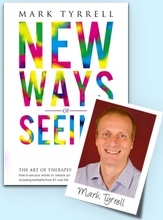
"How do you see your future?" can be a very valuable question.
“The most important thing in changing human behaviour is the person’s motivation.”
– Milton H. Erickson, M.D.
“My life is over. What have I got to look forward to?”
A myriad of emotions, from anger to regret to despair, grappled for prominence on Monica’s exhausted face.
I’ve noticed that when people ask you what they’ve got to look forward to, they don’t want you to answer.
Some questions are really statements of emphasis. Monica wanted me to appreciate how crappy she felt her life was, and she didn’t want to be countered with sunny-side-up contradictions, no matter how well meaning.
As with humour, in therapy, timing is everything. Sometimes we just need to listen.
“My life isn’t as I expected!”
At fifty, Monica was childless, though not by choice; recently jobless, though had been offered a new position in an up-and-coming industry; and boyfriendless, having recently ended ‘yet another’ relationship.
I gave Monica room to vent.
“I just never thought I’d end up like this!” she told me bleakly.
People sometimes reach the point where the future ain’t what it used to be. Life hasn’t worked out or isn’t working out the way they’d assumed it would. And if the life ahead doesn’t seem to contain what they’d assumed they’d need to be fulfilled and happy, it suddenly seems that there is no real future at all.
How do you see your future?
“How do you see your future?” can be a very valuable question. When we’re young we may not think about it all that much, but with the passing of time our options can start to feel narrower. Time may feel like it’s running out, and the future can feel as though it will inevitably get worse.
Monica didn’t feel she was depressed, just “a bit hopeless” about where her life was headed. I agreed with her assessment; I had noticed that she didn’t fearfully catastrophize about the future so much as feel fatalistic about it.
I taught Monica how to relax deeply and all about depressive thinking styles. We looked at her primal emotional needs, how some were or weren’t being met, and what might need to change for them to be better met in her life. I taught her mindfulness techniques to help her experience the present just as much as the past and the (presumed) future.
But we really needed to help her get a sense that there could be a meaningful future for her.
Here I give you four ways to help clients build a sense of a better future.
Step one: Reframe where necessary
Monica felt as though her life was over, at least in some ways. I wanted to gently challenge this perception.
More than once, Monica had talked about “ending up” a certain way. I reframed this idea, suggesting:
“People often talk of ‘ending up’. They say, ‘I don’t want to end up like…’ or ‘I’ve ended up being…’ And yet the very idea of ending up can be challenged. When do you really ‘end up’? Ninety-year-olds make changes, move house, and have new experiences. And even if a fifty-year-old simply sits in one chair forever, they still haven’t ‘ended up’ – their body will keep on changing, as will their mind. As they say, the one constant is change! So what is all this ‘ending up’ business…?”
Monica had spoken so long about ‘ending up’ that she had stopped really thinking about what that meant. This reframe wasn’t meant to change everything for Monica, simply to begin to loosen some of the calcified and unexamined assumptions she’d developed.
I also used Socratic questions such as:
- Is it possible for someone to feel hopeless about their future only for things to improve and life to feel more meaningful? How might that happen?
- Can a person live a different life from the one they’d expected but still find it meaningful and enjoyable? (Monica actually suggested that it might prove to be more meaningful and enjoyable!)
- Might someone think they want something, but when they get it find it’s not all it was cracked up to be?
- Can a person meet an emotional need in more than one way?
Because we were talking generally, she was able to think around her fixed assumptions. At one point she said, “I used to think that having children was the be-all and end-all of life!” Things were shifting.
Next it was important to help Monica focus her attention in a new and productive way when it came to her future.
Step two: Look to gains, not losses
Monica had lamented at length what she didn’t or wouldn’t have. So I gently and gradually began to help her focus on what she did, and could, and might have.
First, I asked her to list things she felt she didn’t have. Quickly she listed the three main things:
- Children
- A good job
- A loving and lovable partner.
I then asked her to really think about what she did have, and she came up with:
- A nephew and niece
- A job offer and the chance to train for a more interesting role
- Good friends
- A nice place to live
- A supportive mother
- Good health.
Then what she might have:
- Career advancement
- Better fitness
- New friends and colleagues
- A compatible, loving partner.
In the course of this process Monica admitted something really interesting, which led to the next area of focus.
Step three: Link goals to core values
“I don’t want my life to be just about me!” Monica announced. “I want to add value to other people’s lives, to inspire as well as be inspired!”
Life isn’t just about what we can get but also what we can give. Life isn’t a product to be consumed purely for personal satisfaction but a time to learn, contribute, and help others. These are some of the urges, perhaps, in wanting a family.
Monica’s core values seemed to be:
- Integrity
- Honesty
- Perseverance (despite having almost given up around her own future!)
- Kindness
- Love
- Self-development through learning.
I asked her if her job offer would enable her to be proactive and develop those core values. She said yes, potentially, though she needed to learn more to enable her to progress and add more value.
I next asked Monica what kind of relationship she would need, and she said one in which she was loved as much as she loved in return. I asked her about her friends, and she said she already only hung out with people who she felt connected to.
Finally, it was time to help Monica get a sense of at least the possibility of positive progression.
Step four: Enjoy the journey so the destination arrives naturally
When I asked Monica about what she loved to do, she said she loved to write creatively, sing, and laugh with friends. I had her hypnotically experience these states and then suggested she could “notice more of these feelings in her future.”
The left hemisphere of the brain is all about grasping, getting, and manipulating, while the right hemisphere sees wider context, appreciates differing views, and is more generous and more connective.1
The right brain has us do things for their own sake, not for some narrow end or focus. It enjoys walking for the sensuality and connection with nature, not merely as a means to log 10,000 steps. It experiences lovemaking for the immediate joy and connection, not simply as a mechanism for procreation. It doesn’t see time spent with a friend or admiring a beautiful painting or sunset as ‘time wasted’ just because it’s not work!
It’s been suggested that we are all currently living in a more ‘left-brain’ world – one that is reductive, black-or-white, and mechanistic but not so ‘alive’.2 The left-brain world is all about productivity and KPIs, and yet…
When we enjoy the process of life, the outcomes take care of themselves. A date, for example, isn’t just a means to an end in which the prospect is screened carefully and made to jump through selection hoops (though some of that may happen!). It can simply be a chance to be curious and see what, if anything, comes of it; to enjoy the experience or at least to learn something.
The really narrow life is one in which we just tick off a to-do list of things we want before we die. The luminance, wonder, and magnificence of life get squeezed out by self-bureaucratizing attitudes of what we should have, and be, and get.
During hypnotic trance I helped Monica visualize not simply the outcomes of what she would like to pursue in her future but enjoying the process of developing these facets in her future life.
Ultimately, Monica told me that in some ways her life was just beginning.
How to Help Clients See Things Differently
Every therapist knows that it’s one thing to spot a client’s limiting beliefs but quite another to change that belief. Reframing is an art that is endlessly refinable; there are basic principles and some useful techniques, but as with any art, a large part comes from spontaneous creativity. Mark’s course Conversational Reframing will give you not only approaches and tools, but also practice in the position you need to take to reframe effectively and free your clients from their self-imposed prisons. Read more about the online course here.
Notes:
- Watch this wonderful description: https://www.youtube.com/watch?v=dFs9WO2B8uI&ab_channel=RSA
- See McGilchrist, I. (2012). The Master and His Emissary: The Divided Brain and the Making of the Western World. Yale University Press.






